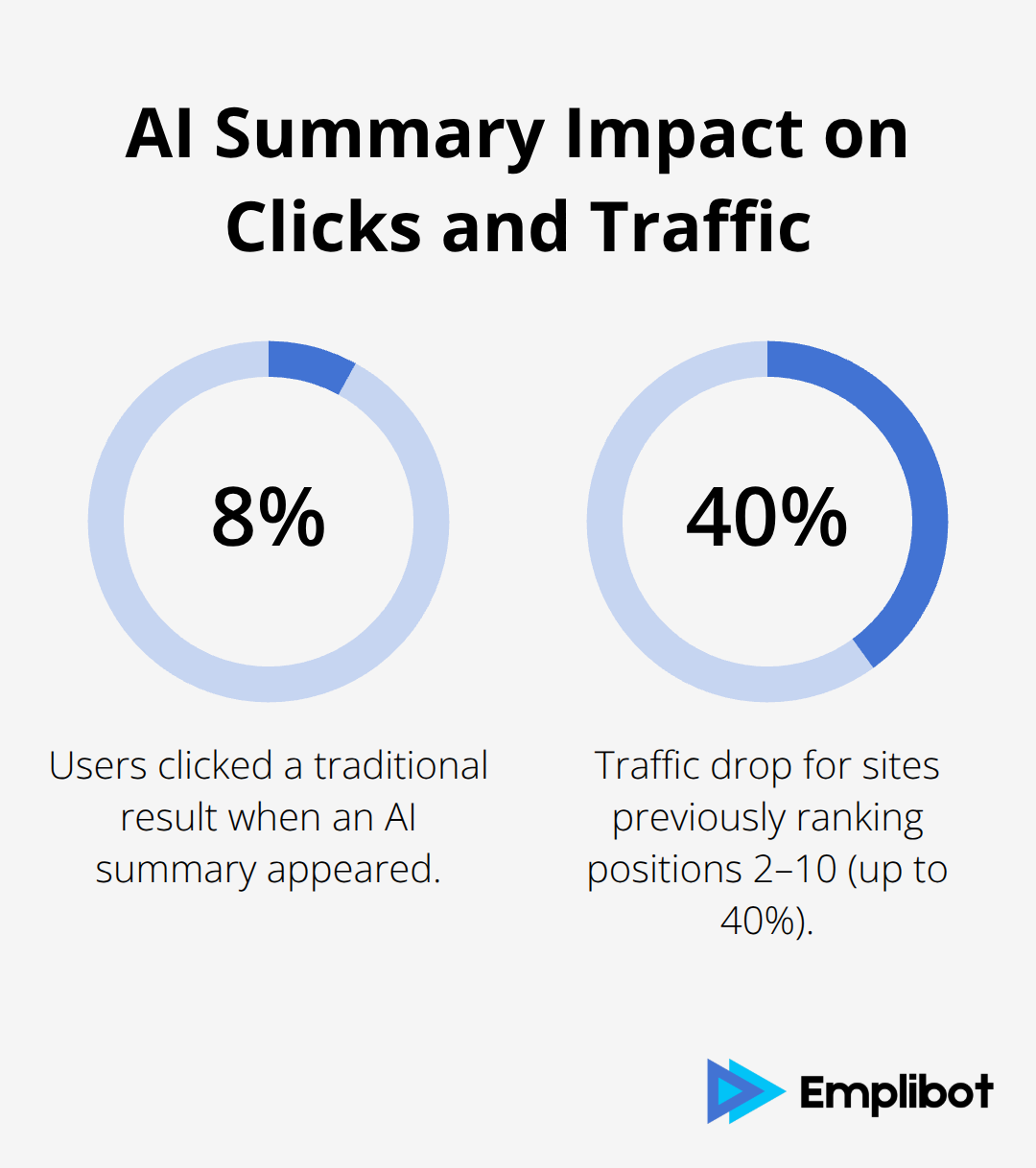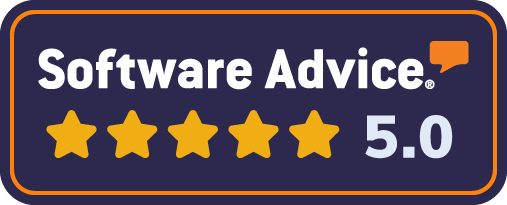Google recently tested an AI-only search option for paying users, replacing traditional result lists with comprehensive summaries and source links. This shift changes how websites compete for visibility.
We at Emplibot recognize that learning how to optimize for Google’s AI-only search tests becomes essential as this technology expands. Your content strategy needs immediate updates to stay competitive in this new search landscape.
Contents
ToggleWhat Google’s AI-Only Search Means for Website Owners
Google’s AI-only search eliminates the traditional ten blue links format that website owners have optimized for since 1998. Instead, users receive a comprehensive AI-generated summary with embedded source citations, which fundamentally changes how traffic flows from search to websites. The AI system pulls information from multiple sources to create one unified answer, so your site competes not just for rankings but for inclusion in AI responses.
Traffic Distribution Creates Winner-Takes-Most Scenarios
This change creates a winner-takes-most scenario where websites mentioned in AI summaries capture significantly more traffic than those buried in traditional results. However, users who encountered an AI summary clicked on a traditional search result link in only 8% of all visits, compared to higher click-through rates when no AI summary appeared.
Websites that previously relied on position 2-10 rankings face traffic drops of up to 40% as users find answers directly in AI summaries without clicking through to source sites. The middle ground disappears-sites either win big through AI inclusion or lose substantial visibility.

Content Authority Determines AI Selection
Google’s AI prioritizes content with clear expertise signals, statistical backing, and proper attribution over generic information. Sites with comprehensive FAQ sections, detailed how-to guides, and data-rich content benefit from AI features like AI Overviews that work to surface quality content from a site owner’s perspective.
The AI system specifically favors content that cites studies, includes publication dates, and provides sample sizes for statistics (making authoritative sourcing non-negotiable for visibility). Websites must now optimize for AI comprehension rather than human keyword matching.

Technical Structure Becomes Essential
AI search requires structured data implementation and answer-first content formatting to maintain search presence. Traditional SEO tactics like keyword density become less relevant while schema markup and clear information hierarchy gain importance. Google Search Console shows you which queries drive traffic to your site and helps identify technical issues that could impact AI visibility. Sites that adapt their technical foundation early position themselves for sustained visibility as AI search expands beyond Google’s current test phase.
Essential Optimization Strategies for AI Search
AI search demands answer-first content structures that place the most valuable information in the opening sentences. Research shows that content appearing in AI summaries typically provides direct answers within the first 50 words, making your introduction paragraph the most valuable real estate on your page. Start each piece with a clear, definitive statement that answers the primary user question before expanding into supporting details.
Schema Markup Drives AI Recognition
FAQ and HowTo schema markup increases your content’s chances of AI inclusion according to recent structured data research from 2024. Google’s AI systems specifically scan for structured data markup to understand content context and extract relevant information for summaries. Implement FAQ schema for question-based content and HowTo schema for process-driven articles using JSON-LD format in your page head.
WordPress sites benefit from plugins like Schema Pro or Yoast SEO that automatically generate proper markup, while custom implementations require careful attention to Google’s structured data guidelines. The markup acts as a direct communication channel between your content and AI systems.
Statistical Authority Commands AI Attention
AI systems prioritize content with specific statistics, publication years, and sample sizes over generic claims. Content with properly attributed data points receives more AI mentions than content without statistical backing. Include the study source, publication year, and sample size for every statistic you reference (AI models specifically look for these authority signals when selecting content for summaries).
Create dedicated stat boxes within your content that highlight key numbers with full attribution. This approach makes it easier for AI systems to extract and cite your information accurately while establishing your content as a reliable source.
Answer-First Content Architecture
Structure your content to answer questions immediately rather than building up to conclusions. Place your main answer in the first paragraph, then support it with evidence and examples in subsequent sections. This format aligns with how AI systems scan and extract information for user queries (matching the way people actually search for answers).
Technical implementation requires proper heading hierarchy and clear topic separation to help AI systems understand your content structure and extract relevant portions for different user queries. AI-powered tools can analyze your content structure and suggest improvements for better AI visibility.
Technical Implementation for AI Search Readiness
Internal Link Architecture for Entity Hubs
Internal link architecture requires strategic entity clusters to help AI systems understand your content relationships and topical authority. Create hub pages for your main topics and connect related content through contextual internal links with descriptive anchor text that reinforces your expertise areas.
AI systems scan internal link patterns to determine which pages represent your strongest content clusters. Concentrate your most authoritative pages around 3-5 core topics rather than spread thin across numerous subjects. Sites with focused entity clusters benefit from increased AI visibility according to search behavior analysis, as search queries that trigger AI Overviews have become increasingly conversational.
Your hub pages should contain comprehensive topic coverage with links to support articles that explore specific aspects in greater detail.
Technical Attribution Standards for AI Citations
Stat boxes require specific formats that AI systems recognize for proper attribution and inclusion in search summaries. Include the data source, publication year, sample size, and methodology for every statistic you present within dedicated HTML containers or structured data markup.
AI models specifically scan for publication dates within 24 months and sample sizes when they select statistics for inclusion in search results. Research shows the majority of studies have sample sizes over 1,000 participants, with a mean planned sample size of 3,986. Create standardized templates for your statistical presentations that include researcher names, institution affiliations, and study URLs when available.

Branded Mention Tracking Systems
Track your branded mentions and source citations through Google Search Console performance reports and tools like Ahrefs or SEMrush that monitor when other sites reference your content. Set up automated alerts for your brand name and key statistics to identify citation opportunities.
Monitor how your data spreads across the web (this signals authority to AI systems that evaluate content quality for search inclusion). Citation tracking helps you understand which statistics perform best and which content formats generate the most references from other authoritative sources.
Final Thoughts
Google’s AI-only search tests demand immediate action across content structure, technical implementation, and authority development. Your success depends on answer-first introductions, comprehensive schema markup, and statistical attribution that AI systems can extract and cite with ease. Sites that implement FAQ and HowTo schema while they build focused entity clusters position themselves for sustained visibility as AI search expands.
The shift from traditional rankings to AI inclusion creates new measurement priorities that focus on branded mentions, source citations, and AI summary appearances rather than keyword positions alone. Track these metrics to understand how well your content performs in AI-driven search environments. Content automation becomes essential for the volume and consistency that AI recognition requires (especially as competition intensifies across all industries).
Websites that adapt quickly to AI-driven search behavior will dominate future search results. Emplibot produces high-quality content that meets AI search requirements while it handles keyword research, content creation, and SEO optimization automatically. Start with your highest-traffic pages, implement proper schema markup, and create stat boxes with full attribution to optimize for Google’s AI-only search tests effectively.










